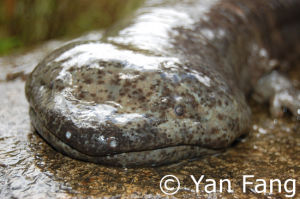Following Lv Jingcai’s recent blog about the Chinese giant salamander EDGE fellow Yan Fang has written a quick update from the project in China.
 In order to devise credible and appropriate conservation and management strategies for endangered species, we focus on the population genetics of Chinese Giant Salamander (CGS). We would like to use the mitochondrial and microsatellite makers to estimate the genetic diversity and population structure of this species.
In order to devise credible and appropriate conservation and management strategies for endangered species, we focus on the population genetics of Chinese Giant Salamander (CGS). We would like to use the mitochondrial and microsatellite makers to estimate the genetic diversity and population structure of this species.
In 2000, Murphy et al. distinguished one population from Huangshan is distinctive with others. Here one population from Guangxi province is detected to be more special. The genetic distance between this population and other populations is more than 3%. However, the divergence within this population is very limited. This kind of small population is at risk of going extinct because of demographic stochasticity and genetic drift. So the population in Guangxi is needed priority protection. 
Local people said that CGS once lived in a big river. But now they are bred by local people separately. This human captive breeding could disturb the natural gene flow and cause the inbreeding. We hope our further genetic research could be used as a proof to correct this human activity.